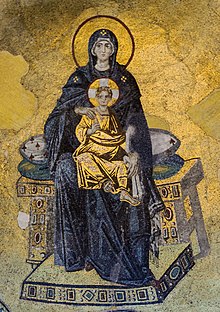This is an old revision of this page, as edited by MaybeItsBecauseImALondoner (talk | contribs) at 21:00, 14 January 2025. The present address (URL) is a permanent link to this revision, which may differ significantly from the current revision.
Revision as of 21:00, 14 January 2025 by MaybeItsBecauseImALondoner (talk | contribs)(diff) ← Previous revision | Latest revision (diff) | Newer revision → (diff)| This article needs additional citations for verification. Please help improve this article by adding citations to reliable sources. Unsourced material may be challenged and removed. Find sources: "Nicopeia" – news · newspapers · books · scholar · JSTOR (January 2025) (Learn how and when to remove this message) |

Nikopoia (sometimes transliterated Nikopea, Nikopeia or Nicopeia; literally 'bringer of victory') is a title of the Virgin Mary and a type of icon in Byzantine art showing Mary frontally, seated on a throne and holding the Christ Child in her arms. It is similar to the Theotokos Kyriotissa and the Tuscan 'Madonna in Majesty'.
Possibly imitating an example in Hagia Sofia, the Venetians placed a similar image in St Mark's Basilica. A conceptually similar idea in the Western Church is Our Lady of Victory.
References
This art-related article is a stub. You can help Misplaced Pages by expanding it. |
This Christianity-related article is a stub. You can help Misplaced Pages by expanding it. |